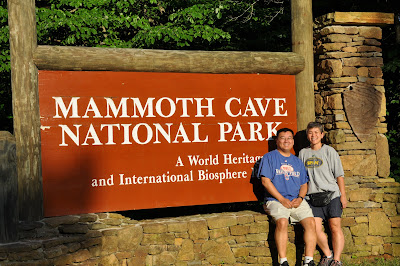First thing this morning, we said goodbye to my folks and headed for parts unknown... to us, at least! Any place south and east of Champaign-Urbana is unexplored territory!
Who was George Rogers Clark, you ask? Most people know about his younger brother William, who helped lead the famed cross-continental expedition with Meriwether Lewis. But big brother George was notable in his own right, even if our history textbooks don't devote as much ink to his accomplishments.
 |
| Inside the memorial |
We learned that George Rogers Clark organized the Kentucky militia to defend against Native American raids and the British who supplied them during the Revolutionary War. He reasoned that the best way to stop the raids on Kentucky settlers was to seize the British outposts north of the Ohio River.
And so in the summer of 1778, he and his men gained control of the British posts at Kaskaskia, Cahokia, and Vincennes. They were easily taken because these posts were occupied by French settlers who had no real desire to fight for the British. However, by December the British had retaken Fort Sackville in Vincennes, intending to attack the Americans in the Illinois country in the spring.
And so in the summer of 1778, he and his men gained control of the British posts at Kaskaskia, Cahokia, and Vincennes. They were easily taken because these posts were occupied by French settlers who had no real desire to fight for the British. However, by December the British had retaken Fort Sackville in Vincennes, intending to attack the Americans in the Illinois country in the spring.
But before Lt. Governor Henry Hamilton could put his plan into action, Clark and his men made an 18-day trek from Kaskaskia to Vincennes through freezing floodwaters, surprising the British and recapturing the fort on February 25, 1779.
With the signing of the Treaty of Paris in 1783 to end the Revolutionary War, the British ceded the Northwest Territory to the United States. And thanks to George Rogers Clark, the northern boundary was marked by the Great Lakes rather than the Ohio River.
Even though there isn't much to see at this site except for the memorial, we all thought this was an interesting place to visit because of the history that is interpreted here. And J now has the subject picked out for his 8th grade historical figure project in the spring!
From Vincennes, we continued south to Lincoln City, IN and back into the Central time zone. The Lincoln Boyhood National Memorial preserves the location of the farm where Abraham Lincoln spent his formative years, from the age of 7 until his family moved to Illinois when he was 21.
With the signing of the Treaty of Paris in 1783 to end the Revolutionary War, the British ceded the Northwest Territory to the United States. And thanks to George Rogers Clark, the northern boundary was marked by the Great Lakes rather than the Ohio River.
Even though there isn't much to see at this site except for the memorial, we all thought this was an interesting place to visit because of the history that is interpreted here. And J now has the subject picked out for his 8th grade historical figure project in the spring!
From Vincennes, we continued south to Lincoln City, IN and back into the Central time zone. The Lincoln Boyhood National Memorial preserves the location of the farm where Abraham Lincoln spent his formative years, from the age of 7 until his family moved to Illinois when he was 21.
His mother, Nancy Hanks Lincoln, died from milk sickness when he was only 9 years old. Her grave is located at the top of a grassy knoll.
The Cabin Memorial marks where the family cabin once stood.
The site also has a living historical farm, complete with log cabin and other outbuildings. The National Park Service staff actually work the homestead, raising crops and livestock.
 |
| Summer interns, dressed in period clothing, patiently answered our questions |








No comments:
Post a Comment